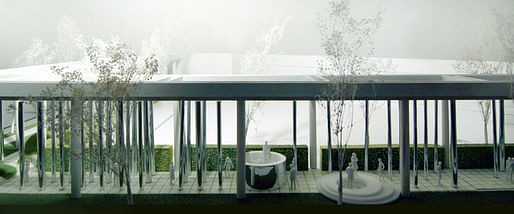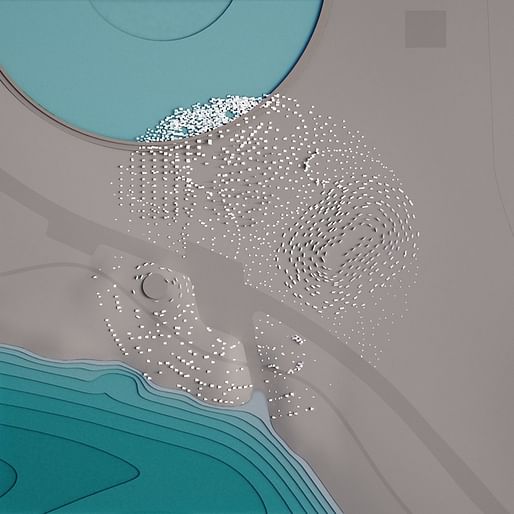
Exhibit Columbus, an “annual exploration of architecture, art, design, and community created to celebrate Columbus’ extraordinary design heritage”, has announced the winners of its inaugural Miller Prize. Named after J. Irwin and Xenia S. Miller, the prize comes with the opportunity to building a temporary installation on one of five sites in the city. The five winners were selected from a large pool that was eventually narrowed down to 10 finalists, each of whom presented their concepts in a public forum at the Columbus City Hall.
The winners are:

studio:indigenous (Chris Cornelius) — First Christian Church by Saarinen and Saarinen (1942)
“Inspired by the dwellings of the Miyaamia people indigenous to Indiana, Cornelius adorns a walkway leading to First Christian Church with a contemporary “wigwam” - wiikiaami in the Miyaamia language - constructed of rebar and copper scales. The swooping conical form is aligned both to the church’s iconic campanile and to mark the autumnal equinox. The copper scales, equally reminiscent of eagle feathers and textile designs, are perforated and patinated to make shifting patterns of sunlight and shade, creating a space for gathering as well as a gateway to Saarinen’s church.”

IKD — Cleo Rogers Memorial Library by I.M. Pei and Partners (1969)
“IKD’s design for Conversation Plinth takes inspiration from the conversation pit in the Miller House and the plinths that elevate the landmarks immediately surrounding the Cleo Rogers Memorial Library. Encircling the Moore sculpture on the eastern half of the site, large shifting timber discs compose a series of plinths that rise upward towards the west and encourage dynamic circulation around the sculpture, allowing the plaza to be experienced in new ways - even by night, thanks to dramatic lighting. IKD plans to collaborate with cross-laminated timber (CLT) specialists to develop CLT made from Indiana hardwood by-products, potentially revolutionizing an industry that currently uses softwoods.”

Oyler Wu Collaborative — Irwin Conference Center by Eero Saarinen and Associates (1954)
“Oyler Wu Collaborative’s research into Eero Saarinen’s oeuvre leads them to focus on three key concepts: Euclidean geometries, solid/void relationships, and tectonics. Their design fabricates a new space within the site by completing the geometries implied by three canopies, legacies of Irwin Conference Center’s history as a drive-up bank. The rectilinear space, defined by the existing canopies and completed by new walls- some solid, some sketched in lines or carved away into voids- is enlivened by sophisticated tectonic interplay with embedded objects derived from Oyler Wu’s particular idiom. The resulting complex of canopies, walls, and benches produce new areas of containment and new points of destination.”

Plan B Architecture and Urbanism — Cummins Corporate Office Building by Kevin Roche John Dinkeloo Associates (1983
“Plan B imagines the columns of the Cummins Corporate Office Building pergola multiplying to form a kind of urban forest, titled Anything can happen in the woods. The new columns are mirrored as a nod to Roche Dinkeloo’s aesthetic and to reflect their surroundings: green hedges, the busy street, and the Post Office opposite, another Roche Dinkeloo design. Landscape forms - conversation pits, outdoor rooms, and grass-covered mounds - punctuate the mirrored woodland, enticing viewers to explore and inhabit a space that is usually passed through or passed by.”

Aranda Lasch — Mill Race Park by Michael Van Valkenburgh Associates with architecture by Stanley Saitowitz (1992)
“Another Circle by Aranda\Lasch responds to the strong formal and architectural elements already present in Mill Race Park, using 2,800 pieces of salvaged Indiana limestone to tie together the round lake, the People Trail, and the river with a new 3.5 acre stone circle. While the design hearkens back to ancient henges and modern earthworks, its primary goal is to articulate fields of activity for contemporary park visitors. Within the circle, stones are placed, stacked or arrayed to create a theater, a beach, a riverfront and areas for games and relaxation: a loose gathering of function inside a scattering of stone.”
The runners-up were Höweler + Yoon, Johnston Marklee and Jonathan Olivares, Ball-Nogues Studio, Baumgartner + Uriu, and Rachel B. Hayes Studio.
“With such a talented group of finalists, we knew we were going to have 10 excellent ideas for our jury to consider, ” said Richard McCoy, director of Landmark Columbus, the organization that created and runs Exhibit Columbus. “We are thrilled with the choices that the jury made, and at the same time grateful to the runners-up in the competition.”
1 Comment
This makes me so damn giddy, and I can't wait until August to see these in my hometown. I really love IKD's design, and Oyler/Wu's as well. I'm not sure about the Aranda/Lasch and Plan B proposals but will reserve judgement until August.
Block this user
Are you sure you want to block this user and hide all related comments throughout the site?
Archinect
This is your first comment on Archinect. Your comment will be visible once approved.